Project organization functions similarly to a project management road plan. It outlines who is responsible for what, who they report to, and how information should be shared among all parties involved.
There are four categories of organizational structures, and each one has a different set of effects on how projects are managed inside the organization:
- Functional
- Project
- Matrix
- Composite

Functional
The majority of businesses are split along functional lines, meaning that each “division” is arranged according to a certain sort of activity, like sales, engineering, or production.
Project managers often don’t have much power under this organization to acquire resources or oversee budgets and timelines. To use resources from other departments, they need permission, which can be a difficult process. This is a result of the functional organization’s architecture, which prioritizes divisional service delivery over project deliverables.
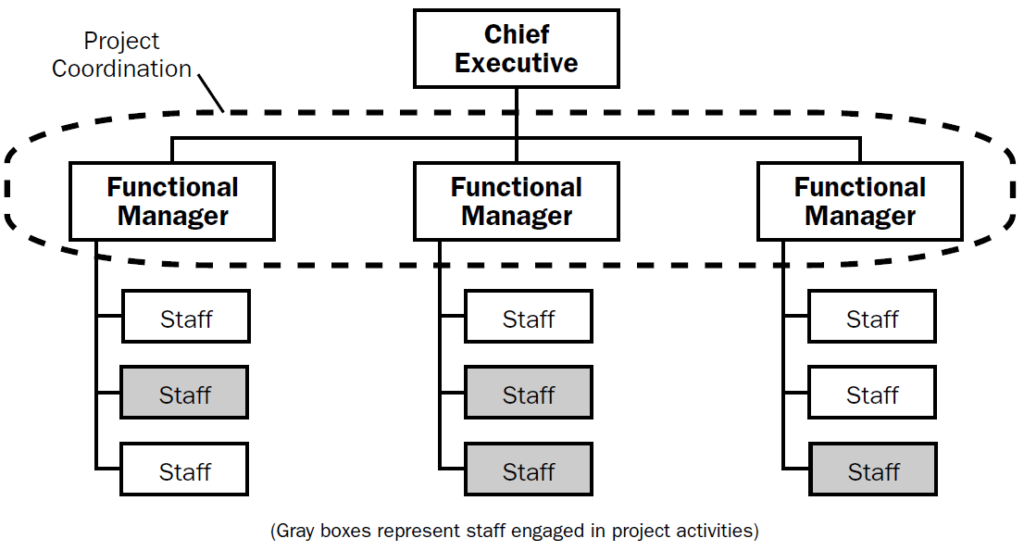
Project-Oriented
The project-oriented organization is at the other extreme of the spectrum. These businesses are organized around projects since the majority of their work is done on a project basis.
Project managers often work full-time in the position, and in the case of smaller initiatives, they may oversee many projects concurrently.
Project managers often have a lot of autonomy and power under this organization. They can utilize resources with minimal permission needed.
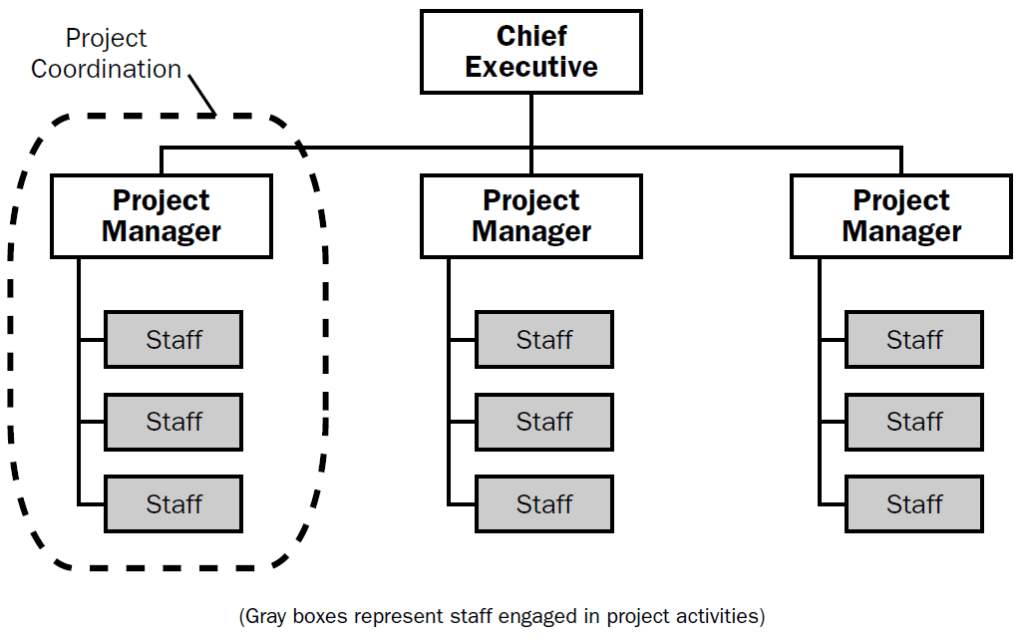
Matrix
Even if functional structures and project-oriented structures are at different ends of the spectrum, it is conceivable to fall anywhere in the middle (a hybrid). Actually, the majority of firms fall somewhere along the spectrum, using a framework that allows project managers to have some additional power without sacrificing their commitment to provide useful services.
A project manager is usually allocated in a part-time or full-time role from inside one of the functional departments in a matrix organization. They are tasked with assigning project team members from other departments, who are somewhat relieved of their departmental responsibilities. Consequently, the project may be given top attention while the functional division services are still provided.
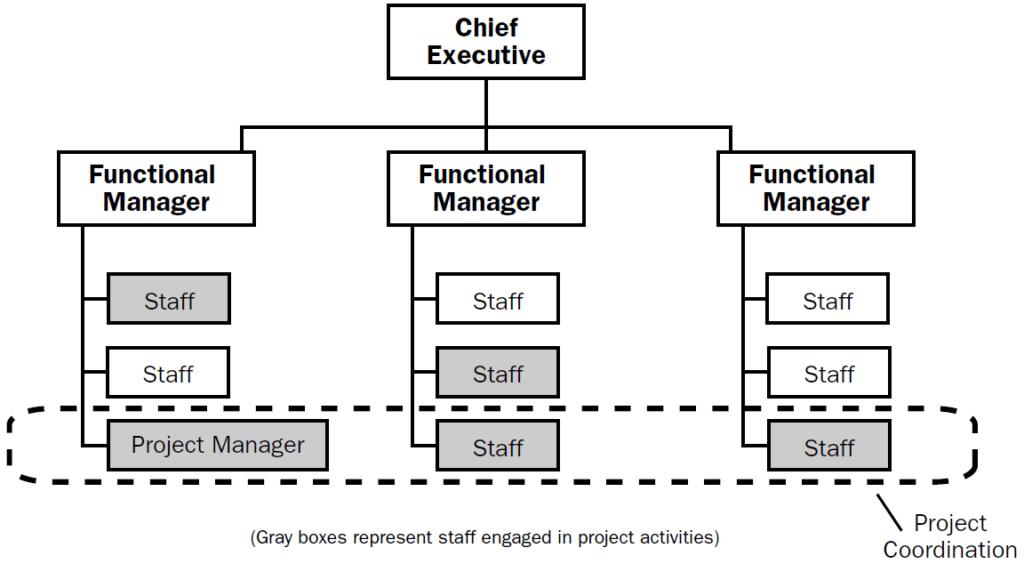
Weak matrix
A weak matrix prevents the project team from managing the project and keeps it under the control of functional managers.
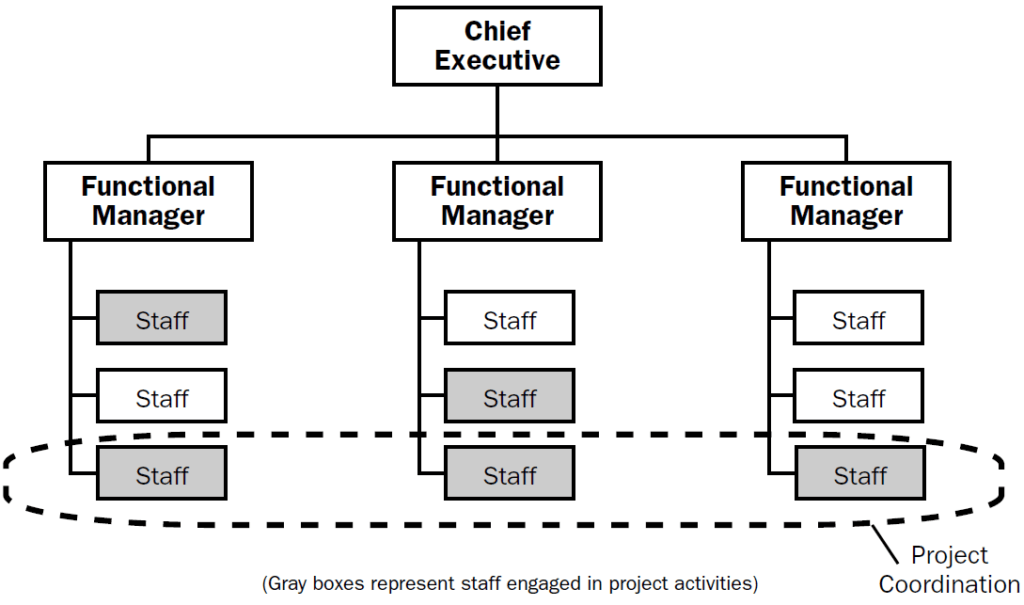
Strong matrix
An organizational structure with a strong matrix still functions well, but it also has a distinct project management division. Although the project manager and functional managers are on the same level, all project roles are still performed inside the functional divisions.
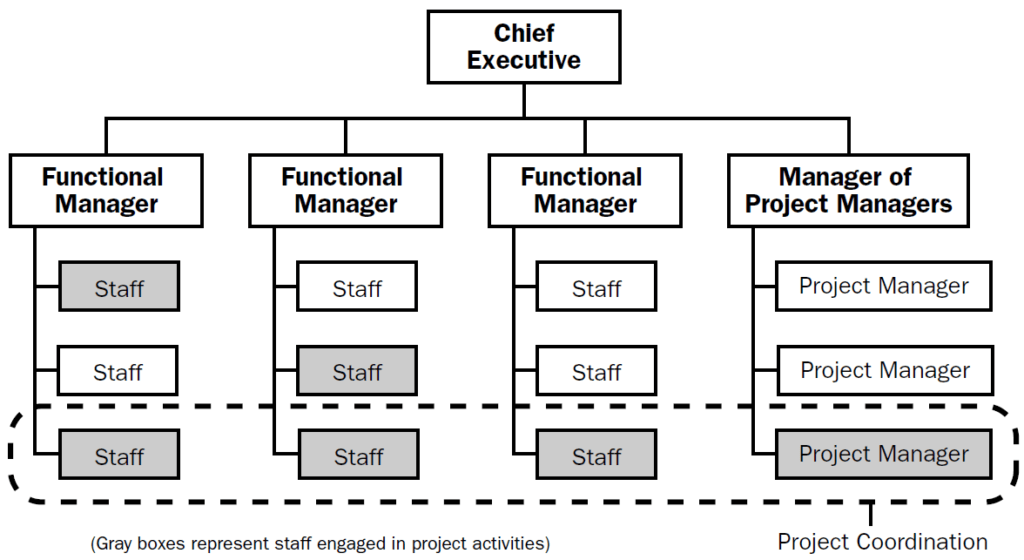
Composite
Matrix organizations are halfway between functional organizations and project-oriented organizations, which are at different extremes of the spectrum. However, it is feasible to make use of both structures simultaneously. As a result, the composite structure, the fourth alternative, has to be discussed.
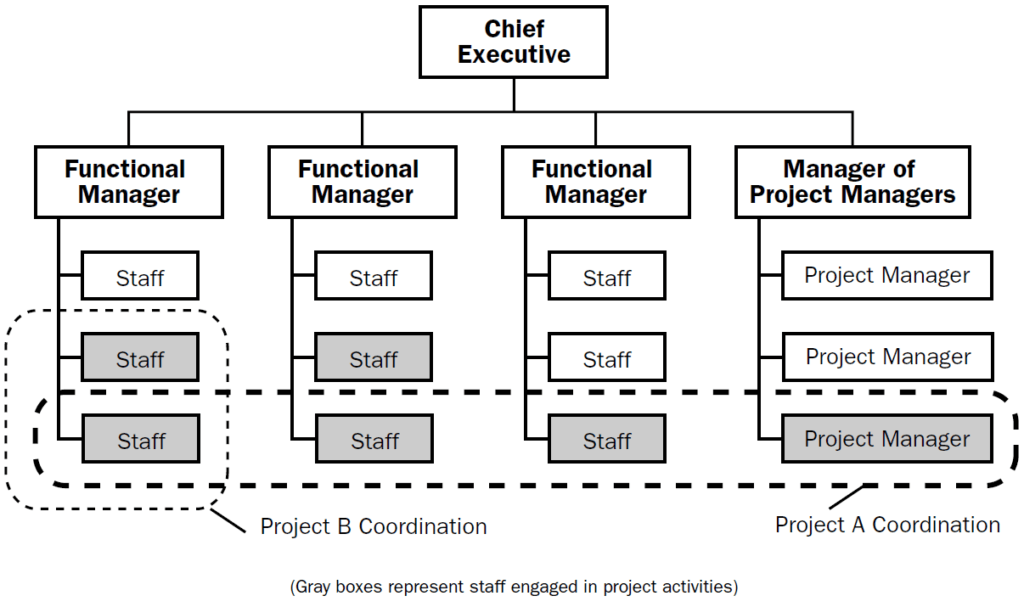
Types of Teams
The team, Task Force : Each member of the single team has direct access to the project manager.
The Network : A system that uses communication with both internal and external partners to provide a good or service is known as a network team structure.
Amoebae : Starts by breaking an organization up into smaller parts known as “amoebas.” The task of creating the unit’s objectives and strategies falls to each amoeba leader. Amoebas work together and put forth a lot of effort from all of their members to attain their objectives.
Satellite : Satellite teams appear to be organized into “small groups with connected indirectly .” Because the members of the collocated team work together on a daily basis, they communicate information in the same way that a collocated team does. They frequently fail to communicate knowledge with others who are not there.
Team roles
https://www.belbin.com/: Organization & Leadership – Project ManagementAccording to the Belbin model, an unstable situation might arise in a team consisting of individuals with comparable workplace habits and dispositions. Consider a team, for instance, whose members all base their decisions on facts and reason rather than feelings.
The 9 Belbin team roles
- The Monitor Evaluator (thought-oriented)
- The Specialist (thought-oriented)
- The Plant (thought-oriented)
- The Shaper (action-oriented)
- The Implementer (action-oriented)
- The Completer/Finisher (action-oriented)
- The Coordinator (people-oriented)
- The Team Worker (people-oriented)
- The Resource Investigator (people-oriented)
Thought-oriented

Action-oriented

People-oriented

The Stages Of Project Team Development
Tuckman’s model
https://www.projectmanagement.com/blog-post/15192/the-five-stages-of-team-development-and-the-role-of-the-project-manager: Organization & Leadership – Project ManagementA team is a collection of people who collaborate to achieve a common objective. Every team member contributes in a different way to the overall objective, utilizing a special set of abilities to carry out a team duty. Nevertheless, every member of the team has the same mindset and approach.
Bruce Tuckman, a psychologist, created the Five Stages of Team Development in 1965.

- Forming : The formative stage is the first. Currently, most team members are worried about who makes the decisions and their place in the group. You will play a key role in team development as a project manager, and others will turn to you for direction and assurance.
- Storming : At this point, the group discusses the issues it will tackle and its plan for working together. As team members voice their own opinions and views, they will become more open-minded with one another and frequently approach the project manager about particular issues pertaining to the project.
- Norming : Team members will start to become used to the current work. They will settle disputes and establish “norms” for their cooperative behavior. There is a hierarchy set up, and the project will go forward faster with less focus on team building.
- Performing : Currently, the project manager’s role is more straightforward. There will be notable advancement achieved when the team members collaborate as a cohesive entity. Project management will prioritize future team creation and task delegation. The staff will be extremely driven and self-sufficient, thus little supervision will be needed.
- Adjourning : Adjourning is the fifth stage of group growth. The process of adjourning differs greatly among teams. While some teams go in silence, others do so in joy or with regret. Every team should be sincerely commended for their coordinated efforts, regardless of the project’s duration or level of accomplishment. Leaders have a great chance to celebrate the project’s completion, foster enduring relationships, and consider the team’s progress during the adjourning phase.

Project Leadership
Leading many teams working on a project together toward successful completion is a talent known as project leadership.
Understanding the duties and obligations of the project leader is essential for any business. You can maximize their abilities and guarantee project delivery on schedule when you know what to anticipate from this team’s professionals. In order to guarantee that your team members acquire the abilities necessary to properly oversee any project process, it also helps to plan specialized training courses for them.
7 Models of Team Effectiveness
https://www.kornferry.com/content/dam/kornferry/docs/pdfs/driving-team-effectiveness.pdf: Organization & Leadership – Project ManagementThe GRPI model : introduced in 1972 by Richard Beckhard
GRPI : Goals, Roles, Procedures, Interpersonal relationships
The Lencioni model : Absence of trust, Fear of conflict, Lack of commitment, Avoidance of accountability, Inattention to results

The Tuckman model : Refere project development section
The Google model :
- Psychological safety: People tend to not take risks if they do not feel secure.
- Dependability: To deliver high-quality work on time, people have to count on each other.
- Structure and clarity: Goals, roles, and plans have to be clear.
- Meaning of work: Team members will be more productive if the work they do is meaningful for them personally.
- Impact of work: People must believe that what they do matters.
The LaFasto and Larson model :
A team effectiveness model known as “The Five Dynamics of Teamwork and Collaboration” was proposed by Frank LaFasto and Carl Larson in 2001.
- Team member: Identify their skills in order to pick the right person
- Team relationships: The right people help build healthy working relationships
- Team problem solving: Good working relationships make it possible to solve difficult problems together
- Team leadership: The right leadership will enhance a team’s success
- Organization environment: The right company culture promotes commitment
The T7 model :
A team effectiveness model known as T7 was created in 1995 by Michael Lombardo and Robert Eichinger. It was termed so because it included seven components, all of which began with the letter “T.”
Internal:
- Thrust – where you’re aiming; a common goal or objective
- Trust – trust in your teammates to support you
- Talent – the individual skills required to complete the task
- Teamwork skills – the ability to work as part of a team
- Task skills – Ability to complete tasks
External:
- Team leader fit – A leader who works well with the team and one members will follow
- Team support from the organization – An organization that enables the team by providing adequate resources and support

The Katzenback and Smith model :
Douglas Smith and Jon Katzenbach developed a triangle model of team success in 1993. Every point in this structure is a goal. You must focus on the three sides of the triangle, or team-effectiveness aspects, in order to attain it:





